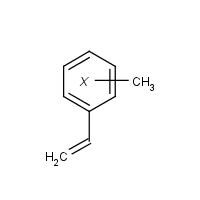Vinyl toluene
Agent Name
Vinyl toluene
Alternative Name
Methyl styrene
CAS Number
25013-15-4
Formula
C9-H10
Major Category
Plastics & Rubber

Synonyms
Methyl styrene; 3- and 4-Vinyl toluene (mixed isomers); Benzene, ethenylmethyl-; Ethenylmethylbenzene; Methylethenylbenzene; Methylstyrene; Methylvinylbenzene; Styrene, ar-methyl-; Styrene, methyl- (mixed isomers); Toluene, vinyl- (mixed isomers); Tolylethylene; Vinyl toluene; Vinyltoluene; Vinyltoluene,industrial; alpha,beta-Styrene; [ChemIDplus] UN2618
Category
Styrenes
Description
Colorless liquid with a strong, disagreeable odor; [NIOSH]
Sources/Uses
Used as a monomer in the production of plastics and surface coatings and as an intermediate in the synthesis of certain insecticides; [ACGIH]
Comments
Vinyl toluene is similar to styrene in its toxicological properties. Fatty degeneration of the liver occurs in acute animal studies. Human subjects found the odor detectable at 50 ppm and objectionable at 300 ppm. [ACGIH] Mainly an eye and respiratory tract irritant, it can cause central nervous system depression after absorption of high doses. [NIOSH Guidelines for Chemical Hazards] A skin, eye, and respiratory tract irritant; Inhalation of high concentrations may cause CNS effects; May cause liver injury; [ICSC] Vinyltoluenes, stabilized (UN2618) has warning of explosive polymerization; [ERG 2016]
Biomedical References
Exposure Assessment
Skin Designation (ACGIH)
No
TLV (ACGIH)
10 ppm
PEL (OSHA)
100 ppm
MAK
20 ppm
IDLH (NIOSH)
400 ppm
Excerpts from Documentation for IDLHs
Other animal data: A considerable number of rats and guinea pigs exposed to 3,000 ppm for 7 to 8 hours/day, 5 days/week for up to 6 months died [Gerarde 1960; Wolf et al. 1956]. Rats and guinea pigs had slight changes in liver and kidney weights and some reduction in body weight following exposure to 800 ppm for 7 hours/day, 5 days/week for 27 days [Wolf et al. 1956]. No adverse effects were noted in rats, rabbits, mice, monkeys, and guinea pigs exposed 7 hours/day, 5 days/week for 5 months to 200 ppm [Wolf et al. 1956]. . . . Human data: Four volunteers reported a definite unpleasant odor and slight eye irritation after about 2 minutes of exposure to 200 ppm [Wolf et al. 1956]. Strong eye and nasal irritation has been noted at concentrations above 600 ppm [Gerarde 1960; Wolf et al. 1956].
Vapor Pressure
1.6 mm Hg
Odor Threshold Low
10 ppm
Lethal Concentration
LC50 (mice) = 3,020 mg/m3/4h
Explosive Polymerization
Yes
Explanatory Notes
Odor threshold from "Quick Guide: The Electronic NIOSH Pocket Guide to Chemical Hazards"; Flash point = 60 deg C; VP from HSDB;
NFPA
high ambient temp required
Adverse Effects
Neurotoxin
Acute solvent syndrome
Hepatotoxin
Hepatoxic (a) from occupational exposure (secondary effect) or (b) in animal studies or in humans after ingestion
IARC Carcinogen
Not classifiable
ACGIH Carcinogen
Not Classifiable
Diseases, Processes, and Activities Linked to This Agent
Diseases
Occupational diseases associated with exposure to this agent:
Processes
Industrial Processes with risk of exposure: